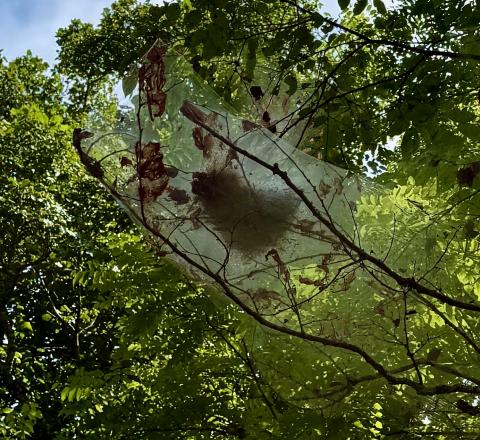Webs in Your Trees

Fall Webworms are numerous this year, and while not harmful to the tree, their messy webs are unsightly in the landscape.
By Steve Roark
Volunteer Cumberland Gap National Historical Park
You may have noticed trees with end branches covered with a gaum of spidery webbing. The cause is a pesky little caterpillar called Fall Webworm, whose population seems to be up this year.
Seems like whenever I write about a tree pest it involves a foreign invader that got loose on us. But Fall Webworm (Hyphantria cunea) is actually a native species that shows up this time of year. The simplest way to describe them is to go through their life cycle. The larval caterpillars are the eating machine stage that hatch out in mid-summer from eggs the females laid on the underside of leaves. They are pale yellow with an orange head and are covered with long whitish hairs that occur in tufts. They start off small but end up being around an inch or so long at maturity. Soon after they hatch the larvae spin a silken web over foliage they want to eat, typically at the end branches, which protects them from predators. As they grow larger, they expand the web tent to enclose more leaves, which can eventually be up to two or three feet long. The type of feeding they do is called skeletonization, where they eat everything but the veins, leaving behind a leaf skeleton. The larvae mature about 6 weeks after hatching, when they will drop to the ground and pupate in the soil to overwinter. They emerge in early summer as medium-sized white moths, which mate and start the cycle of life over.
The worms feed on most hardwood trees, and are partial to hickory, oak, walnut, redbud, cherry, and crabapple. While they can defoliate a small tree, they rarely kill it. Larger trees are normally unharmed by what little damage they do to them, and the problem is cosmetic rather than health: a web tent full of leaf skeletons and bug poop is unsightly.
So, if you have these guys eating on your tree, there are a couple of options to control them. If you can reach them simply cut off the branch above the web and destroy it. This would best be done early enough so that the larvae don’t mature and have a chance to pupate. Garden insecticides will kill them (always check the label), but it’s best to catch the worms and the web early while they’re small. The larger web tents will likely be too thick for sprays to penetrate.
You may confuse Fall Webworm with a similar pest called Eastern Tent Caterpillar, which also does the protective web tent thing. But the Eastern Tent is a springtime problem, and their tent is formed at branch crotches rather than branch ends.
- Log in to post comments